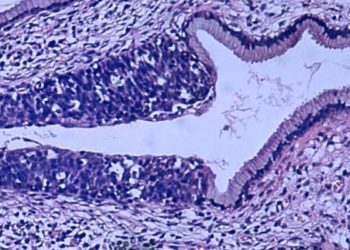FIGO score ≥13 associated with early gestational trophoblastic disease death
1. Patients with an International Federation of Gynecology and Obstetrics (FIGO) score ≥13 comprised three-quarters of early deaths.
2. Among high-risk patients, mortality was significantly higher among women with FIGO score ≥13.
Evidence Rating Level: 2 (Good)
Study Rundown: Gestational trophoblastic neoplasia (GTN) is a group of malignancies that includes invasive mole, gestational choriocarcinoma and 2 rare tumor types. GTN can be preceded by hydatiform moles or nonmolar pregnancies. Risk factors for GTN include prior molar pregnancy and advanced maternal age. Presenting symptoms may vary depending on the type of malignancy but include vaginal bleeding, uterine enlargement, pelvic pain, anemia, hyperemesis gravidarum, hyperthyroidism and early preeclampsia. Treatment is dictated by FIGO prognosis scoring and consists of single agent or combination chemotherapy. Prognosis can be evaluated using the FIGO prognosis scoring system, which accounts for age, type of antecedent pregnancy (partial mole, complete mole, spontaneous abortion, vaginal delivery), time since pregnancy, β-hCG level, tumor size, number and location of metastases and history of failed chemotherapy. Prior evidence shows that FIGO score ≥7 is associated with poorer prognosis. In the present study, authors explored factors associated with the highest risk of early death and found that women with FIGO score ≥13 were most likely to experience death within 4 weeks of treatment and had higher mortality at 5 years.
Strengths of the study included large population database and long-term follow-up. Limitations included selection bias, retrospective design, and variability in chemotherapy regimens, which may be a confounding factor in the observed results. Further prospective studies and randomized controlled trials are needed to identify a threshold for which combination therapy may be preferable for treatment of GTN.
Click to read the study in AJOG
Relevant Reading: The new FIGO 2000 staging and risk factor scoring system for gestational trophoblastic disease: description and critical assessment
In-Depth [retrospective cohort]: This study evaluated the clinical characteristics and outcomes of 974 women with GTN. The primary outcomes of interest were survival and early death, defined as death within 4 weeks of treatment initiation.
Among the 140 patients classified as high-risk (FIGO score ≥7), the 5-year mortality rate was 38.4% for women with FIGO score ≥13, compared with 4.9% in women with FIGO score <13 (p < 0.0001). 75% of early deaths were among women with FIGO score ≥13.
Image: CC/Wiki/Nephron
©2015 2 Minute Medicine, Inc. All rights reserved. No works may be reproduced without expressed written consent from 2 Minute Medicine, Inc. Inquire about licensing here. No article should be construed as medical advice and is not intended as such by the authors or by 2 Minute Medicine, Inc.




![The ABCD2 score: Risk of stroke after Transient Ischemic Attack (TIA) [Classics Series]](https://www.2minutemedicine.com/wp-content/uploads/2013/05/web-cover-classics-with-logo-medicine-BW-small-jpg-350x250.jpg)

![Adverse pregnancy outcomes associated with thrombophilias [Classics Series]](https://www.2minutemedicine.com/wp-content/uploads/2015/07/Classics-2-Minute-Medicine-e1436017941513-75x75.png)
